Public Health in Health and Social Care: UK Disease Report Analysis
VerifiedAdded on 2020/01/16
|17
|5706
|144
Report
AI Summary
This report provides a comprehensive analysis of public health in the United Kingdom, focusing on the roles of various agencies in determining health levels and disease prevalence within communities. It explores the epidemiology of HIV and Type 2 Diabetes, examining their impact and prevalence rates. The report assesses the effectiveness of different strategies and approaches used to control the incidence of these diseases, including social strategies, advertising, and prevention programs. Furthermore, it delves into current priorities and approaches to service provision for individuals with these conditions, analyzing the relationship between HIV prevalence and health service requirements. The impact of lifestyle choices on the future needs of Health and Social Care (HSC) services is also evaluated, along with the health and well-being priorities for individuals in HSC settings. The report assesses the effectiveness of strategies and policies designed to ensure health and well-being and suggests potential changes to improve individual outcomes, including an evaluation of activities promoting behavior change for maximizing health. The report is a detailed examination of public health challenges and strategies within the UK context.

Public Health in Health and
Social Care
1
Social Care
1
Paraphrase This Document
Need a fresh take? Get an instant paraphrase of this document with our AI Paraphraser
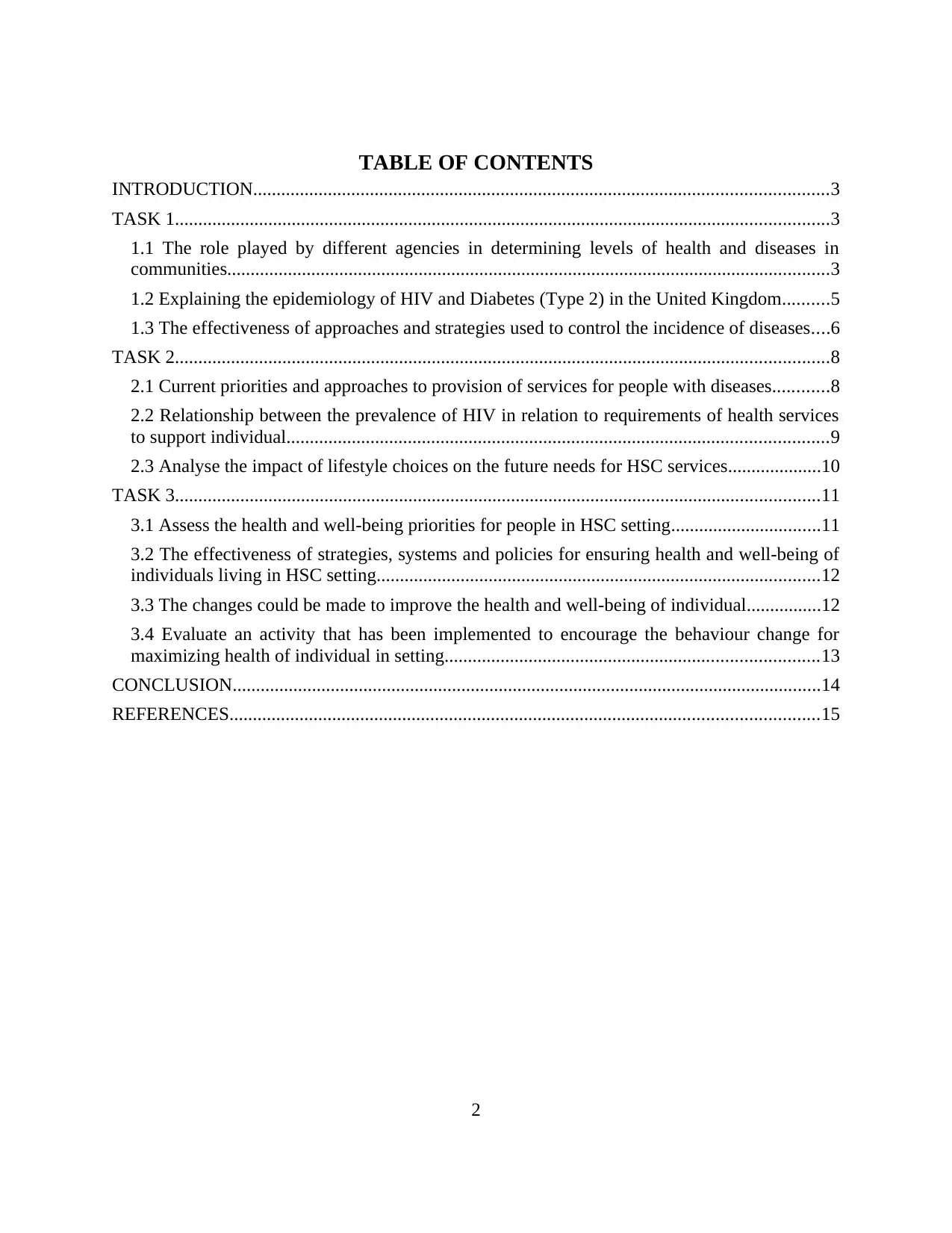
TABLE OF CONTENTS
INTRODUCTION...........................................................................................................................3
TASK 1............................................................................................................................................3
1.1 The role played by different agencies in determining levels of health and diseases in
communities.................................................................................................................................3
1.2 Explaining the epidemiology of HIV and Diabetes (Type 2) in the United Kingdom..........5
1.3 The effectiveness of approaches and strategies used to control the incidence of diseases....6
TASK 2............................................................................................................................................8
2.1 Current priorities and approaches to provision of services for people with diseases............8
2.2 Relationship between the prevalence of HIV in relation to requirements of health services
to support individual....................................................................................................................9
2.3 Analyse the impact of lifestyle choices on the future needs for HSC services....................10
TASK 3..........................................................................................................................................11
3.1 Assess the health and well-being priorities for people in HSC setting................................11
3.2 The effectiveness of strategies, systems and policies for ensuring health and well-being of
individuals living in HSC setting...............................................................................................12
3.3 The changes could be made to improve the health and well-being of individual................12
3.4 Evaluate an activity that has been implemented to encourage the behaviour change for
maximizing health of individual in setting................................................................................13
CONCLUSION..............................................................................................................................14
REFERENCES..............................................................................................................................15
2
INTRODUCTION...........................................................................................................................3
TASK 1............................................................................................................................................3
1.1 The role played by different agencies in determining levels of health and diseases in
communities.................................................................................................................................3
1.2 Explaining the epidemiology of HIV and Diabetes (Type 2) in the United Kingdom..........5
1.3 The effectiveness of approaches and strategies used to control the incidence of diseases....6
TASK 2............................................................................................................................................8
2.1 Current priorities and approaches to provision of services for people with diseases............8
2.2 Relationship between the prevalence of HIV in relation to requirements of health services
to support individual....................................................................................................................9
2.3 Analyse the impact of lifestyle choices on the future needs for HSC services....................10
TASK 3..........................................................................................................................................11
3.1 Assess the health and well-being priorities for people in HSC setting................................11
3.2 The effectiveness of strategies, systems and policies for ensuring health and well-being of
individuals living in HSC setting...............................................................................................12
3.3 The changes could be made to improve the health and well-being of individual................12
3.4 Evaluate an activity that has been implemented to encourage the behaviour change for
maximizing health of individual in setting................................................................................13
CONCLUSION..............................................................................................................................14
REFERENCES..............................................................................................................................15
2
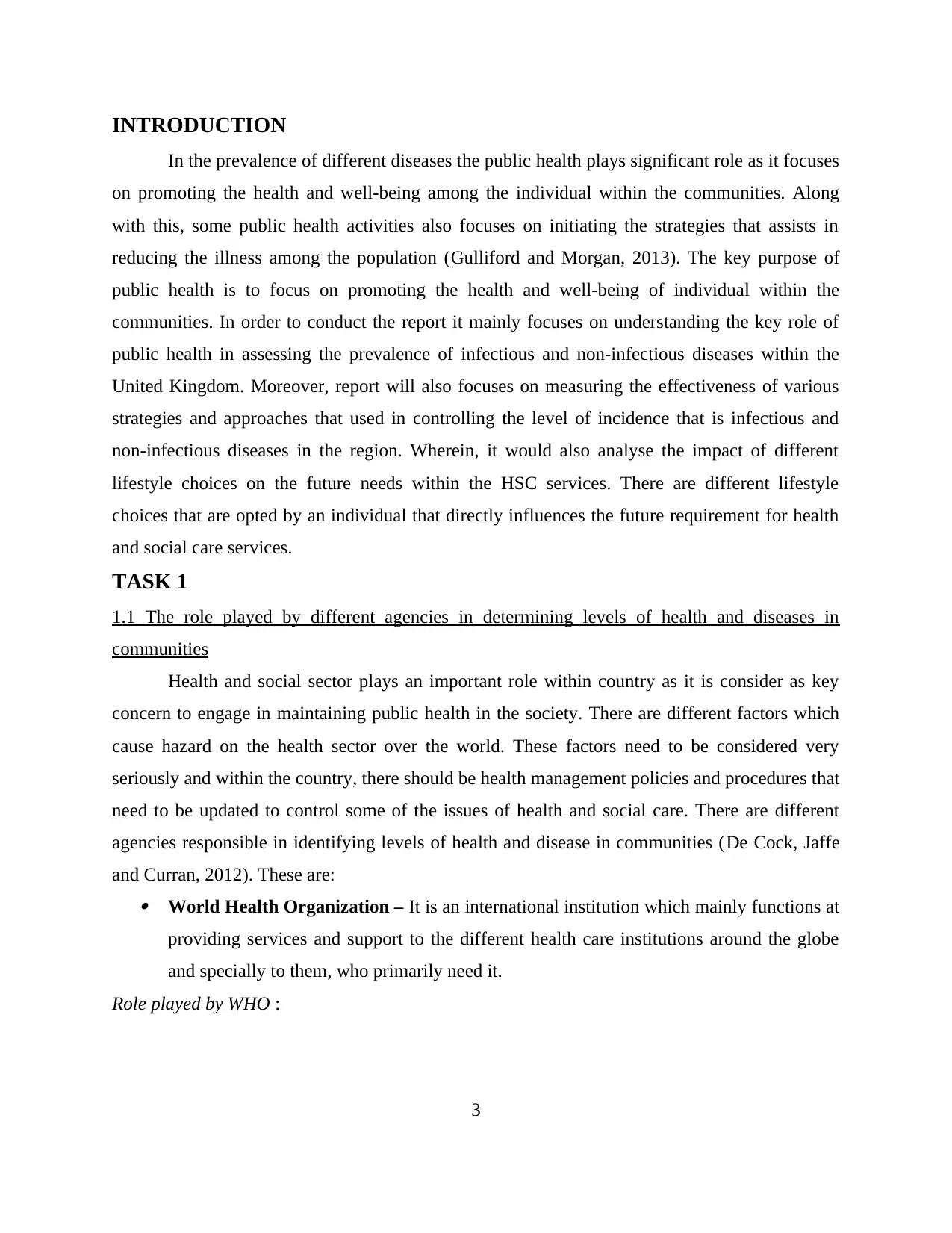
INTRODUCTION
In the prevalence of different diseases the public health plays significant role as it focuses
on promoting the health and well-being among the individual within the communities. Along
with this, some public health activities also focuses on initiating the strategies that assists in
reducing the illness among the population (Gulliford and Morgan, 2013). The key purpose of
public health is to focus on promoting the health and well-being of individual within the
communities. In order to conduct the report it mainly focuses on understanding the key role of
public health in assessing the prevalence of infectious and non-infectious diseases within the
United Kingdom. Moreover, report will also focuses on measuring the effectiveness of various
strategies and approaches that used in controlling the level of incidence that is infectious and
non-infectious diseases in the region. Wherein, it would also analyse the impact of different
lifestyle choices on the future needs within the HSC services. There are different lifestyle
choices that are opted by an individual that directly influences the future requirement for health
and social care services.
TASK 1
1.1 The role played by different agencies in determining levels of health and diseases in
communities
Health and social sector plays an important role within country as it is consider as key
concern to engage in maintaining public health in the society. There are different factors which
cause hazard on the health sector over the world. These factors need to be considered very
seriously and within the country, there should be health management policies and procedures that
need to be updated to control some of the issues of health and social care. There are different
agencies responsible in identifying levels of health and disease in communities (De Cock, Jaffe
and Curran, 2012). These are: World Health Organization – It is an international institution which mainly functions at
providing services and support to the different health care institutions around the globe
and specially to them, who primarily need it.
Role played by WHO :
3
In the prevalence of different diseases the public health plays significant role as it focuses
on promoting the health and well-being among the individual within the communities. Along
with this, some public health activities also focuses on initiating the strategies that assists in
reducing the illness among the population (Gulliford and Morgan, 2013). The key purpose of
public health is to focus on promoting the health and well-being of individual within the
communities. In order to conduct the report it mainly focuses on understanding the key role of
public health in assessing the prevalence of infectious and non-infectious diseases within the
United Kingdom. Moreover, report will also focuses on measuring the effectiveness of various
strategies and approaches that used in controlling the level of incidence that is infectious and
non-infectious diseases in the region. Wherein, it would also analyse the impact of different
lifestyle choices on the future needs within the HSC services. There are different lifestyle
choices that are opted by an individual that directly influences the future requirement for health
and social care services.
TASK 1
1.1 The role played by different agencies in determining levels of health and diseases in
communities
Health and social sector plays an important role within country as it is consider as key
concern to engage in maintaining public health in the society. There are different factors which
cause hazard on the health sector over the world. These factors need to be considered very
seriously and within the country, there should be health management policies and procedures that
need to be updated to control some of the issues of health and social care. There are different
agencies responsible in identifying levels of health and disease in communities (De Cock, Jaffe
and Curran, 2012). These are: World Health Organization – It is an international institution which mainly functions at
providing services and support to the different health care institutions around the globe
and specially to them, who primarily need it.
Role played by WHO :
3
⊘ This is a preview!⊘
Do you want full access?
Subscribe today to unlock all pages.

Trusted by 1+ million students worldwide

▪ it provides it services to low performing health care providers on a per country
basis, newly debilitated areas and the likes.
▪ The organization also joins forces with other necessary health care organization
in order to help them in implementation of certain programs and local activities.
▪ It has the responsibility regarding identifying causes and magnitudes or problems
relating to health and also their solutions. It then, apply solutions and evaluate the
impact (Chowell and Nishiura, 2014).
▪ It focuses on chronic diseases like cancer and HIV. WHO also took some
measures to reduce the effect of Diabetes. NHS- it is an another organization which take care about health and social sector in
country. It takes care of hospitals, clinic and provides other supportive services.
Role played by NHS:
▪ it is a voluntary organization which provide their support to manage the health
activities at local level.
▪ This system provides healthcare to every legal resident of the country and most
services are provides by them are of free of cost (Beyrer, Baral and Brookmeyer,
2012).
▪ The aim of NHS is to meet the need of everyone and also services should be free
at the point of delivery, in case of clinical need. Public Health England- its an executive agency of department of health in UK. It came
into force on 1 April, 2013.
Role played by Public health England :
▪ mission of public health England is to protect and improve the health of nation
and also addressing inequalities.
▪ It is the duty of Public health England tp prevent and manage diseases and
injuries along with other health conditions through promoting health care
behavior , communities and environment.
▪ It aim to provide advice and services to people for living a healthy life (Schmidt
and Brindis, 2012).
4
basis, newly debilitated areas and the likes.
▪ The organization also joins forces with other necessary health care organization
in order to help them in implementation of certain programs and local activities.
▪ It has the responsibility regarding identifying causes and magnitudes or problems
relating to health and also their solutions. It then, apply solutions and evaluate the
impact (Chowell and Nishiura, 2014).
▪ It focuses on chronic diseases like cancer and HIV. WHO also took some
measures to reduce the effect of Diabetes. NHS- it is an another organization which take care about health and social sector in
country. It takes care of hospitals, clinic and provides other supportive services.
Role played by NHS:
▪ it is a voluntary organization which provide their support to manage the health
activities at local level.
▪ This system provides healthcare to every legal resident of the country and most
services are provides by them are of free of cost (Beyrer, Baral and Brookmeyer,
2012).
▪ The aim of NHS is to meet the need of everyone and also services should be free
at the point of delivery, in case of clinical need. Public Health England- its an executive agency of department of health in UK. It came
into force on 1 April, 2013.
Role played by Public health England :
▪ mission of public health England is to protect and improve the health of nation
and also addressing inequalities.
▪ It is the duty of Public health England tp prevent and manage diseases and
injuries along with other health conditions through promoting health care
behavior , communities and environment.
▪ It aim to provide advice and services to people for living a healthy life (Schmidt
and Brindis, 2012).
4
Paraphrase This Document
Need a fresh take? Get an instant paraphrase of this document with our AI Paraphraser

▪ PHE also encourage public health by enhancing discussions, advising
government, NHS and other people and organizations.
▪ It researches, collects and analyze data to improve understanding of health and
also sort out the issues of public health care .
1.2 Explaining the epidemiology of HIV and Diabetes (Type 2) in the United Kingdom
Epidemiology of HIV
Country Current
status of HIV
in people
Adult HIV
prevalence
New
infections
Deaths due to
AIDS
% of antiviral
treatment
United
Kingdom
103700 0.91% 6151 613 91.00%
Despite testing and treatment being free and universally available in UK, around
14000 people were unaware of their HIV infection in UK.
The epidemic in UK mainly affects men who have intercourse with men. The
people the proportion of people diagnosed with HIV who were born in UK (52%)
exceeded the proportion born abroad(48%).
HIV also affects people who inject drugs around 2200 people in UK (What
everyone should know about HIV, 2014).
Also, 25 children were newly diagnosed with HIV. Of these 17 were born abroad
and arrived in UK at an older stage.
There are many HIV testing and counseling in UK. 179 out of 223 health clinics
achieved the recommend testing coverage of 80% people. on the other hand
where black Africans are concerned, one survey detected at an annual HIV
testing rate of just 37%.another study detected in UK that one quarter of black
African or black British ethnicity attended the same health clinic at least once in
the previous five years (HIV and AIDS in the United Kingdom (UK), 2015).
There are HIV programs that has been organized to prevent and control HIV in
UK :
▪ needle and syringe programs
▪ opioid substitution therapy
5
government, NHS and other people and organizations.
▪ It researches, collects and analyze data to improve understanding of health and
also sort out the issues of public health care .
1.2 Explaining the epidemiology of HIV and Diabetes (Type 2) in the United Kingdom
Epidemiology of HIV
Country Current
status of HIV
in people
Adult HIV
prevalence
New
infections
Deaths due to
AIDS
% of antiviral
treatment
United
Kingdom
103700 0.91% 6151 613 91.00%
Despite testing and treatment being free and universally available in UK, around
14000 people were unaware of their HIV infection in UK.
The epidemic in UK mainly affects men who have intercourse with men. The
people the proportion of people diagnosed with HIV who were born in UK (52%)
exceeded the proportion born abroad(48%).
HIV also affects people who inject drugs around 2200 people in UK (What
everyone should know about HIV, 2014).
Also, 25 children were newly diagnosed with HIV. Of these 17 were born abroad
and arrived in UK at an older stage.
There are many HIV testing and counseling in UK. 179 out of 223 health clinics
achieved the recommend testing coverage of 80% people. on the other hand
where black Africans are concerned, one survey detected at an annual HIV
testing rate of just 37%.another study detected in UK that one quarter of black
African or black British ethnicity attended the same health clinic at least once in
the previous five years (HIV and AIDS in the United Kingdom (UK), 2015).
There are HIV programs that has been organized to prevent and control HIV in
UK :
▪ needle and syringe programs
▪ opioid substitution therapy
5
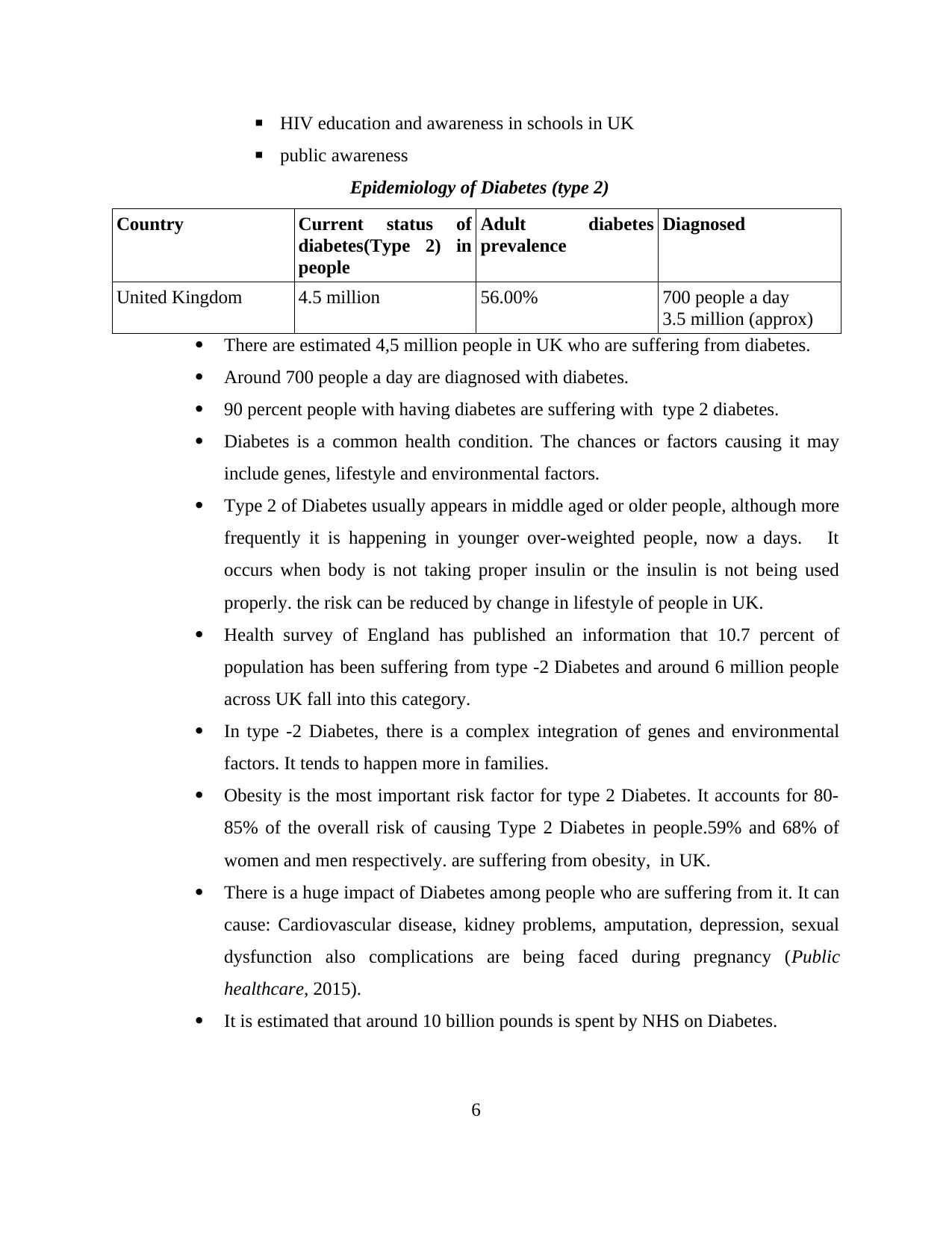
▪ HIV education and awareness in schools in UK
▪ public awareness
Epidemiology of Diabetes (type 2)
Country Current status of
diabetes(Type 2) in
people
Adult diabetes
prevalence
Diagnosed
United Kingdom 4.5 million 56.00% 700 people a day
3.5 million (approx)
There are estimated 4,5 million people in UK who are suffering from diabetes.
Around 700 people a day are diagnosed with diabetes.
90 percent people with having diabetes are suffering with type 2 diabetes.
Diabetes is a common health condition. The chances or factors causing it may
include genes, lifestyle and environmental factors.
Type 2 of Diabetes usually appears in middle aged or older people, although more
frequently it is happening in younger over-weighted people, now a days. It
occurs when body is not taking proper insulin or the insulin is not being used
properly. the risk can be reduced by change in lifestyle of people in UK.
Health survey of England has published an information that 10.7 percent of
population has been suffering from type -2 Diabetes and around 6 million people
across UK fall into this category.
In type -2 Diabetes, there is a complex integration of genes and environmental
factors. It tends to happen more in families.
Obesity is the most important risk factor for type 2 Diabetes. It accounts for 80-
85% of the overall risk of causing Type 2 Diabetes in people.59% and 68% of
women and men respectively. are suffering from obesity, in UK.
There is a huge impact of Diabetes among people who are suffering from it. It can
cause: Cardiovascular disease, kidney problems, amputation, depression, sexual
dysfunction also complications are being faced during pregnancy (Public
healthcare, 2015).
It is estimated that around 10 billion pounds is spent by NHS on Diabetes.
6
▪ public awareness
Epidemiology of Diabetes (type 2)
Country Current status of
diabetes(Type 2) in
people
Adult diabetes
prevalence
Diagnosed
United Kingdom 4.5 million 56.00% 700 people a day
3.5 million (approx)
There are estimated 4,5 million people in UK who are suffering from diabetes.
Around 700 people a day are diagnosed with diabetes.
90 percent people with having diabetes are suffering with type 2 diabetes.
Diabetes is a common health condition. The chances or factors causing it may
include genes, lifestyle and environmental factors.
Type 2 of Diabetes usually appears in middle aged or older people, although more
frequently it is happening in younger over-weighted people, now a days. It
occurs when body is not taking proper insulin or the insulin is not being used
properly. the risk can be reduced by change in lifestyle of people in UK.
Health survey of England has published an information that 10.7 percent of
population has been suffering from type -2 Diabetes and around 6 million people
across UK fall into this category.
In type -2 Diabetes, there is a complex integration of genes and environmental
factors. It tends to happen more in families.
Obesity is the most important risk factor for type 2 Diabetes. It accounts for 80-
85% of the overall risk of causing Type 2 Diabetes in people.59% and 68% of
women and men respectively. are suffering from obesity, in UK.
There is a huge impact of Diabetes among people who are suffering from it. It can
cause: Cardiovascular disease, kidney problems, amputation, depression, sexual
dysfunction also complications are being faced during pregnancy (Public
healthcare, 2015).
It is estimated that around 10 billion pounds is spent by NHS on Diabetes.
6
⊘ This is a preview!⊘
Do you want full access?
Subscribe today to unlock all pages.

Trusted by 1+ million students worldwide
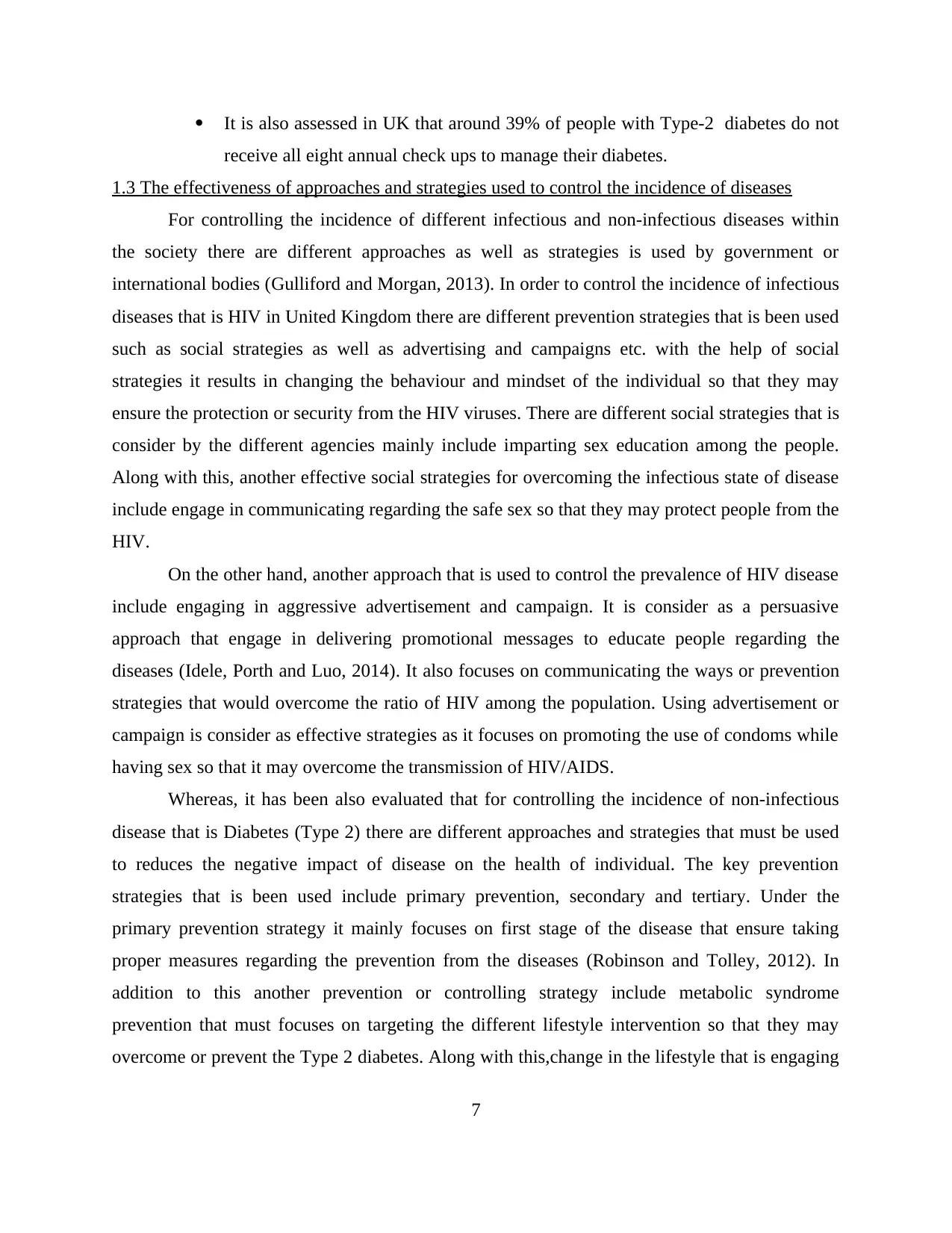
It is also assessed in UK that around 39% of people with Type-2 diabetes do not
receive all eight annual check ups to manage their diabetes.
1.3 The effectiveness of approaches and strategies used to control the incidence of diseases
For controlling the incidence of different infectious and non-infectious diseases within
the society there are different approaches as well as strategies is used by government or
international bodies (Gulliford and Morgan, 2013). In order to control the incidence of infectious
diseases that is HIV in United Kingdom there are different prevention strategies that is been used
such as social strategies as well as advertising and campaigns etc. with the help of social
strategies it results in changing the behaviour and mindset of the individual so that they may
ensure the protection or security from the HIV viruses. There are different social strategies that is
consider by the different agencies mainly include imparting sex education among the people.
Along with this, another effective social strategies for overcoming the infectious state of disease
include engage in communicating regarding the safe sex so that they may protect people from the
HIV.
On the other hand, another approach that is used to control the prevalence of HIV disease
include engaging in aggressive advertisement and campaign. It is consider as a persuasive
approach that engage in delivering promotional messages to educate people regarding the
diseases (Idele, Porth and Luo, 2014). It also focuses on communicating the ways or prevention
strategies that would overcome the ratio of HIV among the population. Using advertisement or
campaign is consider as effective strategies as it focuses on promoting the use of condoms while
having sex so that it may overcome the transmission of HIV/AIDS.
Whereas, it has been also evaluated that for controlling the incidence of non-infectious
disease that is Diabetes (Type 2) there are different approaches and strategies that must be used
to reduces the negative impact of disease on the health of individual. The key prevention
strategies that is been used include primary prevention, secondary and tertiary. Under the
primary prevention strategy it mainly focuses on first stage of the disease that ensure taking
proper measures regarding the prevention from the diseases (Robinson and Tolley, 2012). In
addition to this another prevention or controlling strategy include metabolic syndrome
prevention that must focuses on targeting the different lifestyle intervention so that they may
overcome or prevent the Type 2 diabetes. Along with this,change in the lifestyle that is engaging
7
receive all eight annual check ups to manage their diabetes.
1.3 The effectiveness of approaches and strategies used to control the incidence of diseases
For controlling the incidence of different infectious and non-infectious diseases within
the society there are different approaches as well as strategies is used by government or
international bodies (Gulliford and Morgan, 2013). In order to control the incidence of infectious
diseases that is HIV in United Kingdom there are different prevention strategies that is been used
such as social strategies as well as advertising and campaigns etc. with the help of social
strategies it results in changing the behaviour and mindset of the individual so that they may
ensure the protection or security from the HIV viruses. There are different social strategies that is
consider by the different agencies mainly include imparting sex education among the people.
Along with this, another effective social strategies for overcoming the infectious state of disease
include engage in communicating regarding the safe sex so that they may protect people from the
HIV.
On the other hand, another approach that is used to control the prevalence of HIV disease
include engaging in aggressive advertisement and campaign. It is consider as a persuasive
approach that engage in delivering promotional messages to educate people regarding the
diseases (Idele, Porth and Luo, 2014). It also focuses on communicating the ways or prevention
strategies that would overcome the ratio of HIV among the population. Using advertisement or
campaign is consider as effective strategies as it focuses on promoting the use of condoms while
having sex so that it may overcome the transmission of HIV/AIDS.
Whereas, it has been also evaluated that for controlling the incidence of non-infectious
disease that is Diabetes (Type 2) there are different approaches and strategies that must be used
to reduces the negative impact of disease on the health of individual. The key prevention
strategies that is been used include primary prevention, secondary and tertiary. Under the
primary prevention strategy it mainly focuses on first stage of the disease that ensure taking
proper measures regarding the prevention from the diseases (Robinson and Tolley, 2012). In
addition to this another prevention or controlling strategy include metabolic syndrome
prevention that must focuses on targeting the different lifestyle intervention so that they may
overcome or prevent the Type 2 diabetes. Along with this,change in the lifestyle that is engaging
7
Paraphrase This Document
Need a fresh take? Get an instant paraphrase of this document with our AI Paraphraser
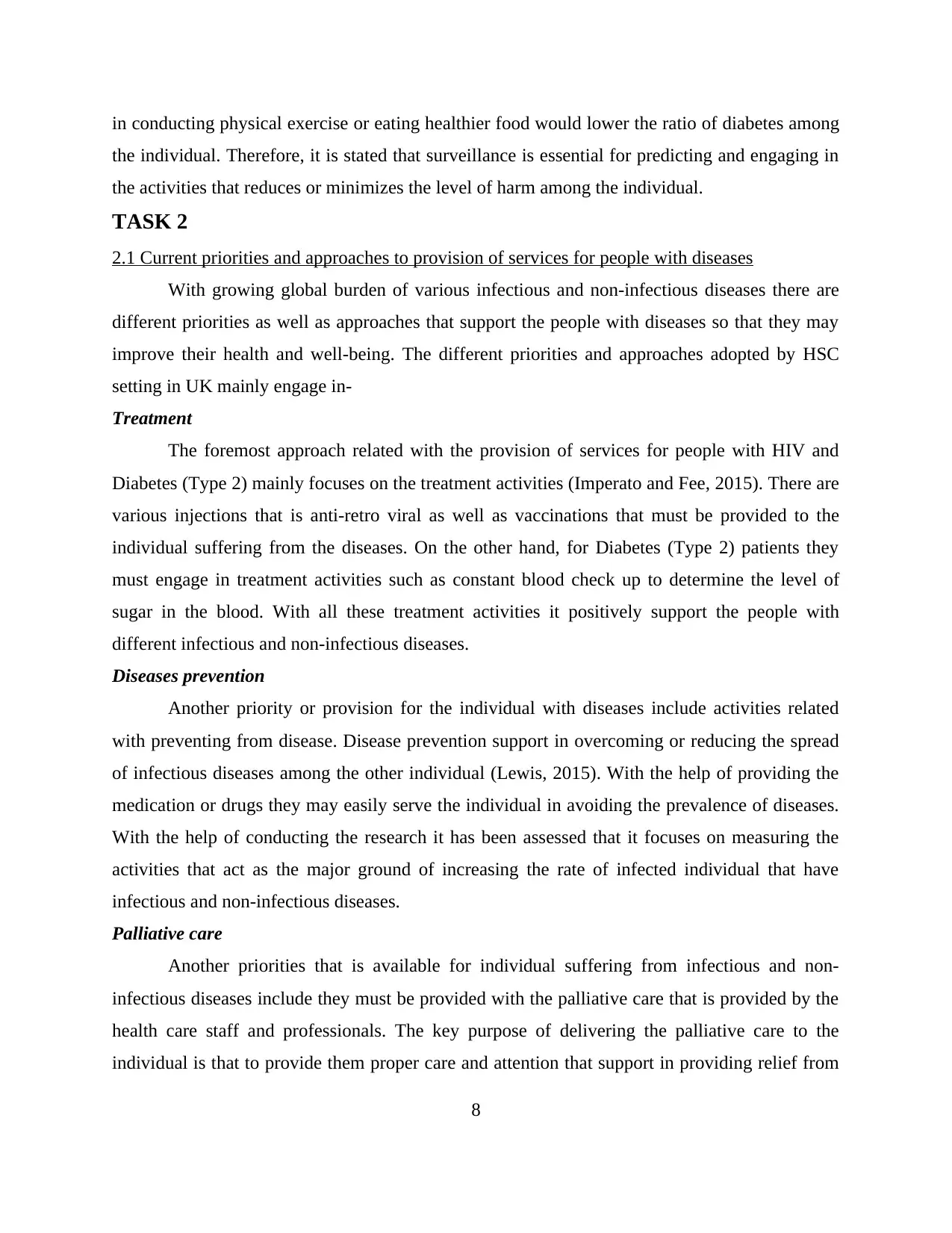
in conducting physical exercise or eating healthier food would lower the ratio of diabetes among
the individual. Therefore, it is stated that surveillance is essential for predicting and engaging in
the activities that reduces or minimizes the level of harm among the individual.
TASK 2
2.1 Current priorities and approaches to provision of services for people with diseases
With growing global burden of various infectious and non-infectious diseases there are
different priorities as well as approaches that support the people with diseases so that they may
improve their health and well-being. The different priorities and approaches adopted by HSC
setting in UK mainly engage in-
Treatment
The foremost approach related with the provision of services for people with HIV and
Diabetes (Type 2) mainly focuses on the treatment activities (Imperato and Fee, 2015). There are
various injections that is anti-retro viral as well as vaccinations that must be provided to the
individual suffering from the diseases. On the other hand, for Diabetes (Type 2) patients they
must engage in treatment activities such as constant blood check up to determine the level of
sugar in the blood. With all these treatment activities it positively support the people with
different infectious and non-infectious diseases.
Diseases prevention
Another priority or provision for the individual with diseases include activities related
with preventing from disease. Disease prevention support in overcoming or reducing the spread
of infectious diseases among the other individual (Lewis, 2015). With the help of providing the
medication or drugs they may easily serve the individual in avoiding the prevalence of diseases.
With the help of conducting the research it has been assessed that it focuses on measuring the
activities that act as the major ground of increasing the rate of infected individual that have
infectious and non-infectious diseases.
Palliative care
Another priorities that is available for individual suffering from infectious and non-
infectious diseases include they must be provided with the palliative care that is provided by the
health care staff and professionals. The key purpose of delivering the palliative care to the
individual is that to provide them proper care and attention that support in providing relief from
8
the individual. Therefore, it is stated that surveillance is essential for predicting and engaging in
the activities that reduces or minimizes the level of harm among the individual.
TASK 2
2.1 Current priorities and approaches to provision of services for people with diseases
With growing global burden of various infectious and non-infectious diseases there are
different priorities as well as approaches that support the people with diseases so that they may
improve their health and well-being. The different priorities and approaches adopted by HSC
setting in UK mainly engage in-
Treatment
The foremost approach related with the provision of services for people with HIV and
Diabetes (Type 2) mainly focuses on the treatment activities (Imperato and Fee, 2015). There are
various injections that is anti-retro viral as well as vaccinations that must be provided to the
individual suffering from the diseases. On the other hand, for Diabetes (Type 2) patients they
must engage in treatment activities such as constant blood check up to determine the level of
sugar in the blood. With all these treatment activities it positively support the people with
different infectious and non-infectious diseases.
Diseases prevention
Another priority or provision for the individual with diseases include activities related
with preventing from disease. Disease prevention support in overcoming or reducing the spread
of infectious diseases among the other individual (Lewis, 2015). With the help of providing the
medication or drugs they may easily serve the individual in avoiding the prevalence of diseases.
With the help of conducting the research it has been assessed that it focuses on measuring the
activities that act as the major ground of increasing the rate of infected individual that have
infectious and non-infectious diseases.
Palliative care
Another priorities that is available for individual suffering from infectious and non-
infectious diseases include they must be provided with the palliative care that is provided by the
health care staff and professionals. The key purpose of delivering the palliative care to the
individual is that to provide them proper care and attention that support in providing relief from
8
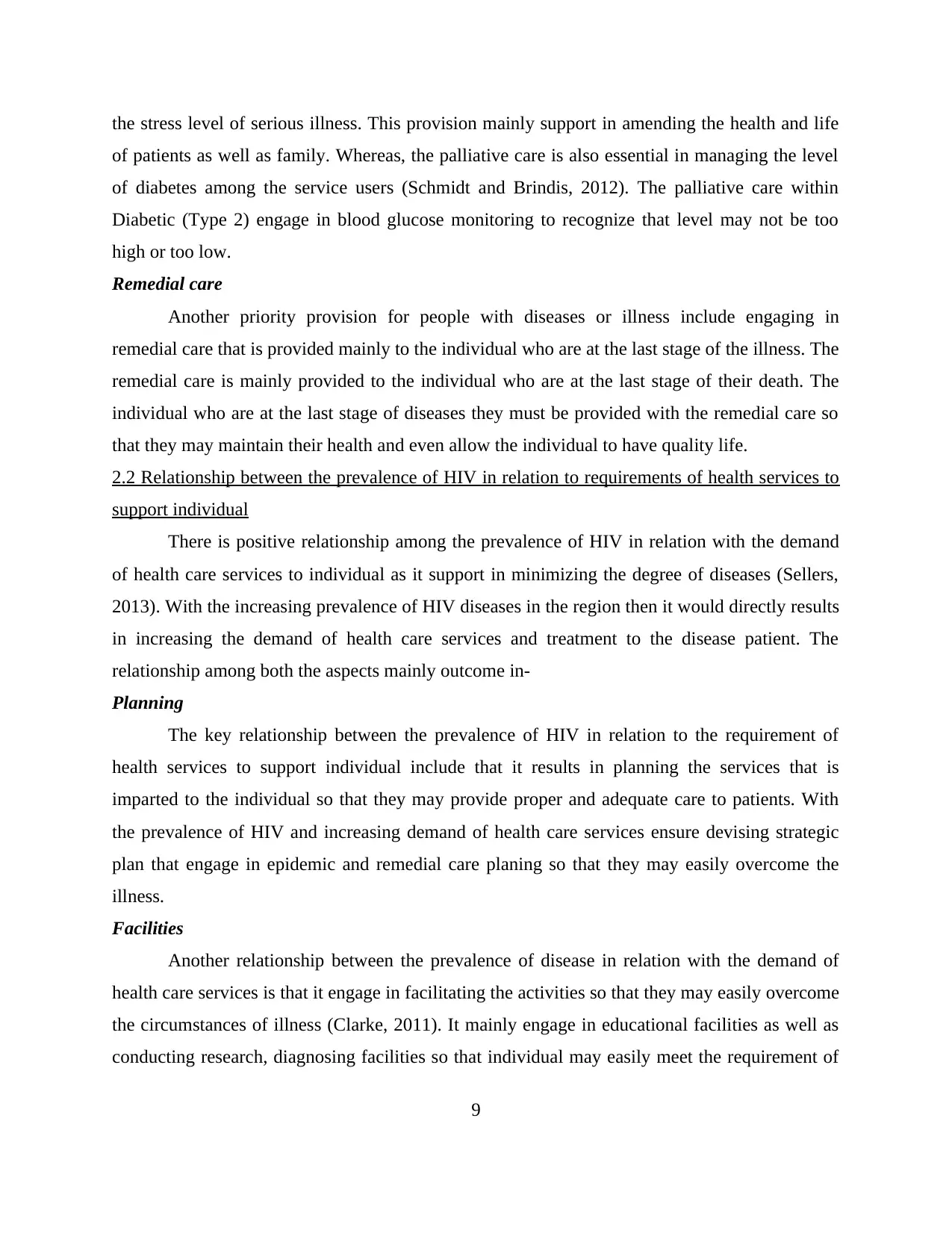
the stress level of serious illness. This provision mainly support in amending the health and life
of patients as well as family. Whereas, the palliative care is also essential in managing the level
of diabetes among the service users (Schmidt and Brindis, 2012). The palliative care within
Diabetic (Type 2) engage in blood glucose monitoring to recognize that level may not be too
high or too low.
Remedial care
Another priority provision for people with diseases or illness include engaging in
remedial care that is provided mainly to the individual who are at the last stage of the illness. The
remedial care is mainly provided to the individual who are at the last stage of their death. The
individual who are at the last stage of diseases they must be provided with the remedial care so
that they may maintain their health and even allow the individual to have quality life.
2.2 Relationship between the prevalence of HIV in relation to requirements of health services to
support individual
There is positive relationship among the prevalence of HIV in relation with the demand
of health care services to individual as it support in minimizing the degree of diseases (Sellers,
2013). With the increasing prevalence of HIV diseases in the region then it would directly results
in increasing the demand of health care services and treatment to the disease patient. The
relationship among both the aspects mainly outcome in-
Planning
The key relationship between the prevalence of HIV in relation to the requirement of
health services to support individual include that it results in planning the services that is
imparted to the individual so that they may provide proper and adequate care to patients. With
the prevalence of HIV and increasing demand of health care services ensure devising strategic
plan that engage in epidemic and remedial care planing so that they may easily overcome the
illness.
Facilities
Another relationship between the prevalence of disease in relation with the demand of
health care services is that it engage in facilitating the activities so that they may easily overcome
the circumstances of illness (Clarke, 2011). It mainly engage in educational facilities as well as
conducting research, diagnosing facilities so that individual may easily meet the requirement of
9
of patients as well as family. Whereas, the palliative care is also essential in managing the level
of diabetes among the service users (Schmidt and Brindis, 2012). The palliative care within
Diabetic (Type 2) engage in blood glucose monitoring to recognize that level may not be too
high or too low.
Remedial care
Another priority provision for people with diseases or illness include engaging in
remedial care that is provided mainly to the individual who are at the last stage of the illness. The
remedial care is mainly provided to the individual who are at the last stage of their death. The
individual who are at the last stage of diseases they must be provided with the remedial care so
that they may maintain their health and even allow the individual to have quality life.
2.2 Relationship between the prevalence of HIV in relation to requirements of health services to
support individual
There is positive relationship among the prevalence of HIV in relation with the demand
of health care services to individual as it support in minimizing the degree of diseases (Sellers,
2013). With the increasing prevalence of HIV diseases in the region then it would directly results
in increasing the demand of health care services and treatment to the disease patient. The
relationship among both the aspects mainly outcome in-
Planning
The key relationship between the prevalence of HIV in relation to the requirement of
health services to support individual include that it results in planning the services that is
imparted to the individual so that they may provide proper and adequate care to patients. With
the prevalence of HIV and increasing demand of health care services ensure devising strategic
plan that engage in epidemic and remedial care planing so that they may easily overcome the
illness.
Facilities
Another relationship between the prevalence of disease in relation with the demand of
health care services is that it engage in facilitating the activities so that they may easily overcome
the circumstances of illness (Clarke, 2011). It mainly engage in educational facilities as well as
conducting research, diagnosing facilities so that individual may easily meet the requirement of
9
⊘ This is a preview!⊘
Do you want full access?
Subscribe today to unlock all pages.

Trusted by 1+ million students worldwide

health care services. In addition to this, engaging in the facilities would also results in reducing
the prevailing of diseases among the individual.
Partnership working
Another relationship include that it engage in enabling partnership working with the
certain agencies and health care professionals so that they may engage in preventing and curing
activities so that they may reduce the prevalence of diseases among the individual. Along with
this, through enabling the partnership working results in delivering advanced medical facilities
and services that meet the requirement of individual with HIV symptoms.
2.3 Analyse the impact of lifestyle choices on the future needs for HSC services
There are different lifestyle choices that are opted by an individual that directly
influences the future requirement for health and social care services. Within the UK individual
mainly have different lifestyle that mainly results in affecting their health condition (Viner, Ozer
and Currie, 2012). The lifestyle choices mainly engage in dietary activities, physical exercises as
well as relaxation activities etc. that positively impact the health and well-being of individual.
With the change in time it results in changing their lifestyle that is in-taking unhealthier food,
drinking and smoking habits etc. would results in requiring HSC services in the future. On the
contrary to this, with the over eating among the individual it might adversely impact the health of
individual as it results in arising the situation of overweight or obesity.
It has been analysed that with the lifestyle choices will directly engage in increasing and
decreasing the risk of injury. With enabling the physical exercise it results in keeping individual
body fit (Pisaniello, Winefield and Delfabbro, 2012). For example, engaging in the activities
such as running, cycling would reduce the risk related with cardiovascular, diabetes, overweight
etc. therefore, this would also required lesser health-care services in the future state. Another
lifestyle choices include having balanced and healthier diet. With consuming the healthier food
and beverages it results in diminishing the fat and the situation of overweight among the
individual. The balanced and healthier diet would results in enabling the healthier lifestyle as
well as it also protect the individual body against the diseases and infections.
Moreover, with the change in lifestyle that is increasing consumption of unhealthier food
as well as increase in drinking and smoking activities would negatively impact the health of
individual. With the increasing in smoking activities it act as the most dangerous issue that
10
the prevailing of diseases among the individual.
Partnership working
Another relationship include that it engage in enabling partnership working with the
certain agencies and health care professionals so that they may engage in preventing and curing
activities so that they may reduce the prevalence of diseases among the individual. Along with
this, through enabling the partnership working results in delivering advanced medical facilities
and services that meet the requirement of individual with HIV symptoms.
2.3 Analyse the impact of lifestyle choices on the future needs for HSC services
There are different lifestyle choices that are opted by an individual that directly
influences the future requirement for health and social care services. Within the UK individual
mainly have different lifestyle that mainly results in affecting their health condition (Viner, Ozer
and Currie, 2012). The lifestyle choices mainly engage in dietary activities, physical exercises as
well as relaxation activities etc. that positively impact the health and well-being of individual.
With the change in time it results in changing their lifestyle that is in-taking unhealthier food,
drinking and smoking habits etc. would results in requiring HSC services in the future. On the
contrary to this, with the over eating among the individual it might adversely impact the health of
individual as it results in arising the situation of overweight or obesity.
It has been analysed that with the lifestyle choices will directly engage in increasing and
decreasing the risk of injury. With enabling the physical exercise it results in keeping individual
body fit (Pisaniello, Winefield and Delfabbro, 2012). For example, engaging in the activities
such as running, cycling would reduce the risk related with cardiovascular, diabetes, overweight
etc. therefore, this would also required lesser health-care services in the future state. Another
lifestyle choices include having balanced and healthier diet. With consuming the healthier food
and beverages it results in diminishing the fat and the situation of overweight among the
individual. The balanced and healthier diet would results in enabling the healthier lifestyle as
well as it also protect the individual body against the diseases and infections.
Moreover, with the change in lifestyle that is increasing consumption of unhealthier food
as well as increase in drinking and smoking activities would negatively impact the health of
individual. With the increasing in smoking activities it act as the most dangerous issue that
10
Paraphrase This Document
Need a fresh take? Get an instant paraphrase of this document with our AI Paraphraser
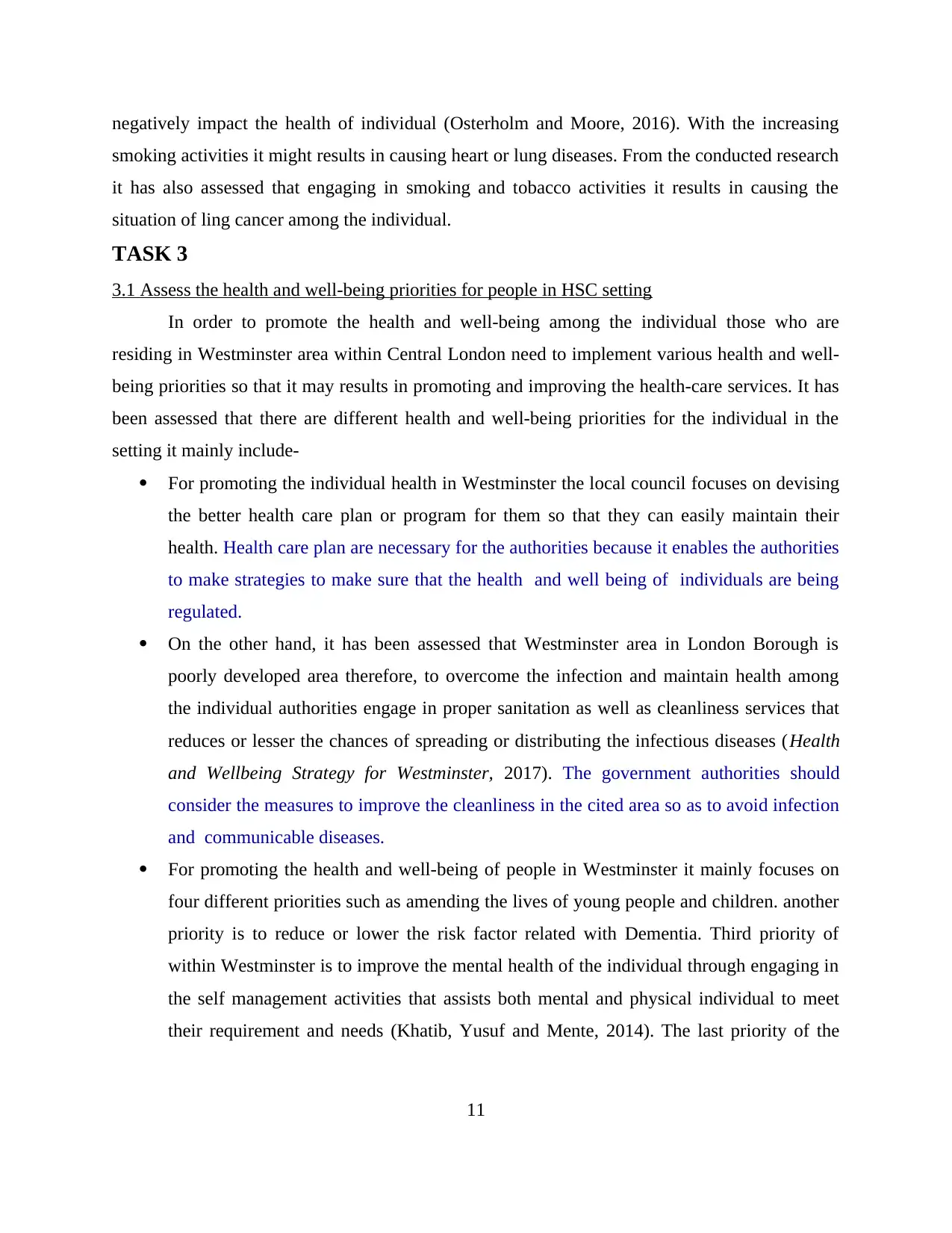
negatively impact the health of individual (Osterholm and Moore, 2016). With the increasing
smoking activities it might results in causing heart or lung diseases. From the conducted research
it has also assessed that engaging in smoking and tobacco activities it results in causing the
situation of ling cancer among the individual.
TASK 3
3.1 Assess the health and well-being priorities for people in HSC setting
In order to promote the health and well-being among the individual those who are
residing in Westminster area within Central London need to implement various health and well-
being priorities so that it may results in promoting and improving the health-care services. It has
been assessed that there are different health and well-being priorities for the individual in the
setting it mainly include-
For promoting the individual health in Westminster the local council focuses on devising
the better health care plan or program for them so that they can easily maintain their
health. Health care plan are necessary for the authorities because it enables the authorities
to make strategies to make sure that the health and well being of individuals are being
regulated.
On the other hand, it has been assessed that Westminster area in London Borough is
poorly developed area therefore, to overcome the infection and maintain health among
the individual authorities engage in proper sanitation as well as cleanliness services that
reduces or lesser the chances of spreading or distributing the infectious diseases (Health
and Wellbeing Strategy for Westminster, 2017). The government authorities should
consider the measures to improve the cleanliness in the cited area so as to avoid infection
and communicable diseases.
For promoting the health and well-being of people in Westminster it mainly focuses on
four different priorities such as amending the lives of young people and children. another
priority is to reduce or lower the risk factor related with Dementia. Third priority of
within Westminster is to improve the mental health of the individual through engaging in
the self management activities that assists both mental and physical individual to meet
their requirement and needs (Khatib, Yusuf and Mente, 2014). The last priority of the
11
smoking activities it might results in causing heart or lung diseases. From the conducted research
it has also assessed that engaging in smoking and tobacco activities it results in causing the
situation of ling cancer among the individual.
TASK 3
3.1 Assess the health and well-being priorities for people in HSC setting
In order to promote the health and well-being among the individual those who are
residing in Westminster area within Central London need to implement various health and well-
being priorities so that it may results in promoting and improving the health-care services. It has
been assessed that there are different health and well-being priorities for the individual in the
setting it mainly include-
For promoting the individual health in Westminster the local council focuses on devising
the better health care plan or program for them so that they can easily maintain their
health. Health care plan are necessary for the authorities because it enables the authorities
to make strategies to make sure that the health and well being of individuals are being
regulated.
On the other hand, it has been assessed that Westminster area in London Borough is
poorly developed area therefore, to overcome the infection and maintain health among
the individual authorities engage in proper sanitation as well as cleanliness services that
reduces or lesser the chances of spreading or distributing the infectious diseases (Health
and Wellbeing Strategy for Westminster, 2017). The government authorities should
consider the measures to improve the cleanliness in the cited area so as to avoid infection
and communicable diseases.
For promoting the health and well-being of people in Westminster it mainly focuses on
four different priorities such as amending the lives of young people and children. another
priority is to reduce or lower the risk factor related with Dementia. Third priority of
within Westminster is to improve the mental health of the individual through engaging in
the self management activities that assists both mental and physical individual to meet
their requirement and needs (Khatib, Yusuf and Mente, 2014). The last priority of the
11
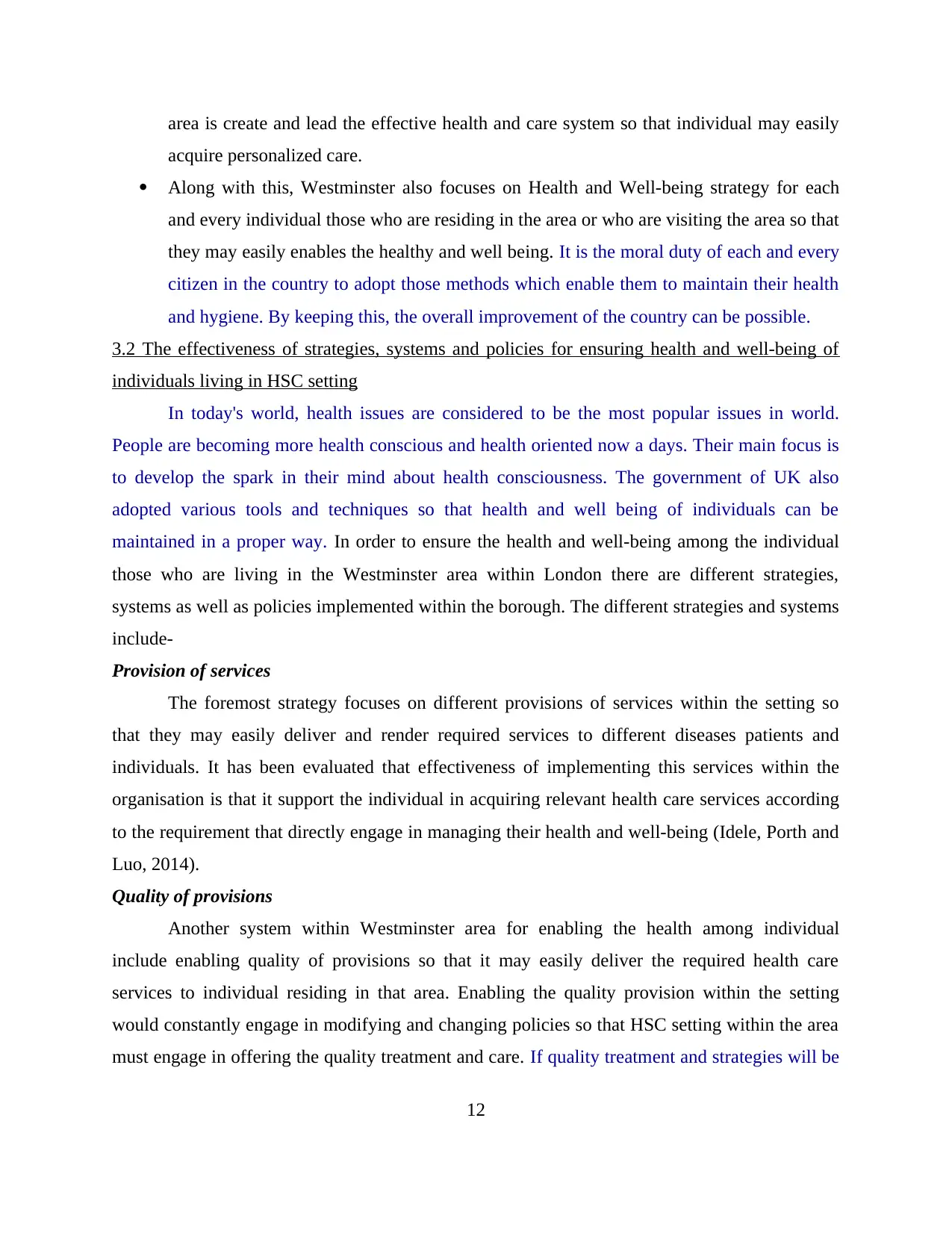
area is create and lead the effective health and care system so that individual may easily
acquire personalized care.
Along with this, Westminster also focuses on Health and Well-being strategy for each
and every individual those who are residing in the area or who are visiting the area so that
they may easily enables the healthy and well being. It is the moral duty of each and every
citizen in the country to adopt those methods which enable them to maintain their health
and hygiene. By keeping this, the overall improvement of the country can be possible.
3.2 The effectiveness of strategies, systems and policies for ensuring health and well-being of
individuals living in HSC setting
In today's world, health issues are considered to be the most popular issues in world.
People are becoming more health conscious and health oriented now a days. Their main focus is
to develop the spark in their mind about health consciousness. The government of UK also
adopted various tools and techniques so that health and well being of individuals can be
maintained in a proper way. In order to ensure the health and well-being among the individual
those who are living in the Westminster area within London there are different strategies,
systems as well as policies implemented within the borough. The different strategies and systems
include-
Provision of services
The foremost strategy focuses on different provisions of services within the setting so
that they may easily deliver and render required services to different diseases patients and
individuals. It has been evaluated that effectiveness of implementing this services within the
organisation is that it support the individual in acquiring relevant health care services according
to the requirement that directly engage in managing their health and well-being (Idele, Porth and
Luo, 2014).
Quality of provisions
Another system within Westminster area for enabling the health among individual
include enabling quality of provisions so that it may easily deliver the required health care
services to individual residing in that area. Enabling the quality provision within the setting
would constantly engage in modifying and changing policies so that HSC setting within the area
must engage in offering the quality treatment and care. If quality treatment and strategies will be
12
acquire personalized care.
Along with this, Westminster also focuses on Health and Well-being strategy for each
and every individual those who are residing in the area or who are visiting the area so that
they may easily enables the healthy and well being. It is the moral duty of each and every
citizen in the country to adopt those methods which enable them to maintain their health
and hygiene. By keeping this, the overall improvement of the country can be possible.
3.2 The effectiveness of strategies, systems and policies for ensuring health and well-being of
individuals living in HSC setting
In today's world, health issues are considered to be the most popular issues in world.
People are becoming more health conscious and health oriented now a days. Their main focus is
to develop the spark in their mind about health consciousness. The government of UK also
adopted various tools and techniques so that health and well being of individuals can be
maintained in a proper way. In order to ensure the health and well-being among the individual
those who are living in the Westminster area within London there are different strategies,
systems as well as policies implemented within the borough. The different strategies and systems
include-
Provision of services
The foremost strategy focuses on different provisions of services within the setting so
that they may easily deliver and render required services to different diseases patients and
individuals. It has been evaluated that effectiveness of implementing this services within the
organisation is that it support the individual in acquiring relevant health care services according
to the requirement that directly engage in managing their health and well-being (Idele, Porth and
Luo, 2014).
Quality of provisions
Another system within Westminster area for enabling the health among individual
include enabling quality of provisions so that it may easily deliver the required health care
services to individual residing in that area. Enabling the quality provision within the setting
would constantly engage in modifying and changing policies so that HSC setting within the area
must engage in offering the quality treatment and care. If quality treatment and strategies will be
12
⊘ This is a preview!⊘
Do you want full access?
Subscribe today to unlock all pages.

Trusted by 1+ million students worldwide
1 out of 17
Related Documents
Your All-in-One AI-Powered Toolkit for Academic Success.
+13062052269
info@desklib.com
Available 24*7 on WhatsApp / Email
![[object Object]](/_next/static/media/star-bottom.7253800d.svg)
Unlock your academic potential
Copyright © 2020–2025 A2Z Services. All Rights Reserved. Developed and managed by ZUCOL.





